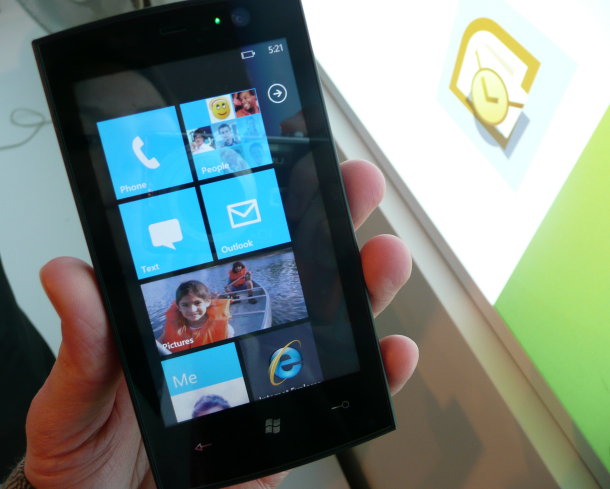Windows Phone 7 to woo consumers first, then business

Microsoft's new mobile operating system goes for gadget fans, not CIOs, in version one
Windows Phone 7 (WP7) - the soon-to-be-unleashed, entirely overhauled operating system for smartphones from Microsoft is not aiming for the enterprise - not yet anyway.
Version one of the OS is squarely aimed at consumers, said Microsoft's ISV developer evangelist Paul Foster speaking at a briefing for developers and press.
"The device emphasis is clearly a consumer device," said Foster. "[WP7's predecessor] Windows Mobile was a very successful business app, but the world changed with a focus on the consumer viewpoint. So we have rebooted our mobile phone product by delivering - along with Windows Mobile, because it still exists there under our Windows Embedded team - a consumer-focused Windows Phone 7."

An early version of Windows Phone 7 being demoed at Mobile World Congress
(Photo credit: Natasha Lomas/silicon.com)
Ultimately WP7 will take up the enterprise baton, leaving Windows Embedded to sit on devices at the ruggedised, bar-code reading end of the mobile value chain, according to Foster: "The task-oriented application, the Fed-Ex, the UPS guy - that's all about mass devices being managed centrally and that is what Windows Mobile does very well."
One big barrier to enterprise use of WP7 is the fact any bespoke business applications companies seek to build would have to be deployed on the public Windows Marketplace for Mobile as there is no provision for private delivery of apps.
"At this moment in time we don't support that," confirmed Foster. "It's top on our list but at this moment in time we don't support it for V1."
But Foster said there's a chance the average office worker could take a fancy to the platform and bring WP7 into the enterprise by the back door. WP7 devices will come with Microsoft Office Mobile, Exchange and SharePoint integration, he noted, and the platform also supports multiple email accounts and calendars. "There's a lot of functionality to facilitate a business person's activities," claimed Foster.
Microsoft has set out a minimum hardware spec for WP7 devices - including having a capacitive touchscreen, GPS, a variety of embedded sensors, and three physical buttons on the front: one for back, one to take the user to the homescreen, and a search button that will be hardwired to Microsoft's Bing search engine, at least initially. "In version one it's all Bing," confirmed Foster, adding that future iterations of the platform may allow users to select a different search engine.
Redmond is also seeking to discourage developers from creating too many free apps for the platform. Registered developers can submit five free apps without incurring any additional charges - beyond their annual Windows Phone developer registration fee (£67 in the UK) - but after the fifth app, each additional free app will cost $20 when submitted to Microsoft.
For paid apps the revenue split will see developers picking up 70 per cent and Microsoft 30 per cent - the same proportion that developers making wares for Apple's iOS, Google's Android platform, RIM's BlackBerry and the Nokia Ovi Store get.
However the experience of developing for WP7 is better than some rival platforms, according to Simon Maddox, a freelance developer who was speaking at the event. "I started Windows Phone 7 development a while ago. You're learning a framework rather than a language. And it's not a complicated framework. A lot of things are done for you," he said.
Maddox, who built the 0870 iPhone app - which lets users find alternate numbers to chargeable 0870 numbers - said porting this app to WP7 took around three hours. "I've got experience with most mobile platforms and [WP7] is much better than something like Symbian or Maemo - which are a complete nightmare," he added.
Asked how many apps Microsoft expects to be on the platform at launch, Microsoft's Foster said the company is aiming for 'quality not quantity' - seeking to cover off "key brands" such as Twitter, rather than going after volume.
"Our intention is to ensure we've got the right style of apps you would typically use - as to opposed to having an enormous, amazing volume," said Foster. "The classic, must-have apps."
Microsoft has made a variety of WP7 development tools and libraries resources available to developers, including tools for Visual Basic developers, along with access to some Microsoft cloud services - including push notifications for WP7 devices, a location resolution service, and even Windows Azure, Microsoft's hosted computing and storage service.
"What we're seeing in the business side... is some Windows Phone applications that are connecting in to Windows Azure," added Foster. "From your device [as a developer] you only have to provide one login and [Windows Azure's] service bus routes the various calls through to those target apps."
WP7 devices will have one of two screen resolutions - either 800 x 480 for large touchscreen devices with the potential for slide-out Qwerty keyboards, or 480 x 320 for 'BlackBerry' style handsets that can incorporate a Qwerty on the front of the device. Microsoft expects the majority of WP7 devices to have the larger screen resolution at launch, with smaller resolution handsets coming later, said Foster.
The Windows Phone Blog has also previously revealed WP7 will not support tethering or allow for removable SD cards, with Microsoft claiming the lack of such features improves the platform's data security credentials.
As for the launch date, Redmond continues to remain tight-lipped - with Microsoft's Foster saying only the first WP7 handset will launch in time for the "holiday season".